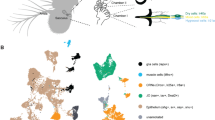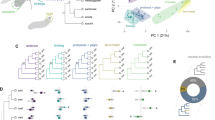Abstract
THE function of the nervous system depends on the formation of a net of appropriate connections, but little is known of the genetic program underlying this process. In Drosophila two genes that specify different types of sense organs have been identified: cut (ct)1,2, which specifies the formation of external sense organs as opposed to chordotonal organs, and pox-neuro (poxn)3, which specifies the formation of poly-innervated (chemosensory) organs as opposed to mono-innervated (mechanosensory) organs. Whether these genes are also involved in specifying the connectivity of the corresponding neurons is not known. The larval sense organs are unsuitable for analysis of the axonal pathway and connections and so we have investigated the effect of poxn on the adult. Here we show that overexpression of poxn induces the morphological trans-formation of mechanosensory into chemosensory bristles on the legs and that the neurons innervating the morphologically transformed bristles follow pathways and establish connections that are appropriate for chemosensory bristles.
This is a preview of subscription content, access via your institution
Access options
Subscribe to this journal
Receive 51 print issues and online access
$199.00 per year
only $3.90 per issue
Buy this article
- Purchase on Springer Link
- Instant access to full article PDF
Prices may be subject to local taxes which are calculated during checkout
Similar content being viewed by others
References
Bodmer, R. et al. Cell 51, 293–307. (1987).
Blochinger, K., Jan, L. Y. & Jan, Y. N. Genes Dev. 5, 1124–1135 (1991).
Dambly-Chaudiere, C. et al. Cell 69, 159–172 (1992).
Bate, C. M. in Handbook of Sensory Physiology (ed. M. Jacobson) Vol. XI (Springer, Berlin, 1976).
Tobler, H., Rothenbühler, V. & Nöthiger, R. Experentia 29, 170–171 (1973).
Held, L. I. Jr Roux's Arch. dev. Biol. 199, 31–47 (1990).
Hartenstein, V. & Posakony, J. Devl Biol. 142, 13–30 (1990).
Murphey, R. K., Possidente, R. K., Vandervorst, P. & Ghysen, A. J. Neurosci. 9, 3209–3217 (1989).
Dethier, V. G. in The Physiology of Insect Senses 126–155 (Methuen, London, 1965).
Treisman, J., Harris, E. & Desplan, C. Genes Dev. 5, 594–604 (1991).
Ghysen, A. Devl Biol. 78, 521–541 (1980).
Teugels, E. & Ghysen, A. Prog. Brain Res. 58, 305–312 (1983).
Ghysen, A. Nature 274, 869–872 (1978).
Author information
Authors and Affiliations
Rights and permissions
About this article
Cite this article
Nottebohm, E., Dambly-Chaudière, C. & Ghysen, A. Connectivity of chemosensory neurons is controlled by the gene poxn in Drosophila. Nature 359, 829–832 (1992). https://doi.org/10.1038/359829a0
Received:
Accepted:
Issue Date:
DOI: https://doi.org/10.1038/359829a0
This article is cited by
-
The organization of the chemosensory system in Drosophila melanogaster: a rewiew
Cell and Tissue Research (1994)
-
Histamine is a major mechanosensory neurotransmitter candidate in Drosophila melanogaster
Cell and Tissue Research (1993)
Comments
By submitting a comment you agree to abide by our Terms and Community Guidelines. If you find something abusive or that does not comply with our terms or guidelines please flag it as inappropriate.



